Understanding Hi-Vis Standards and the Importance of Replacing Used High Visibility Apparel
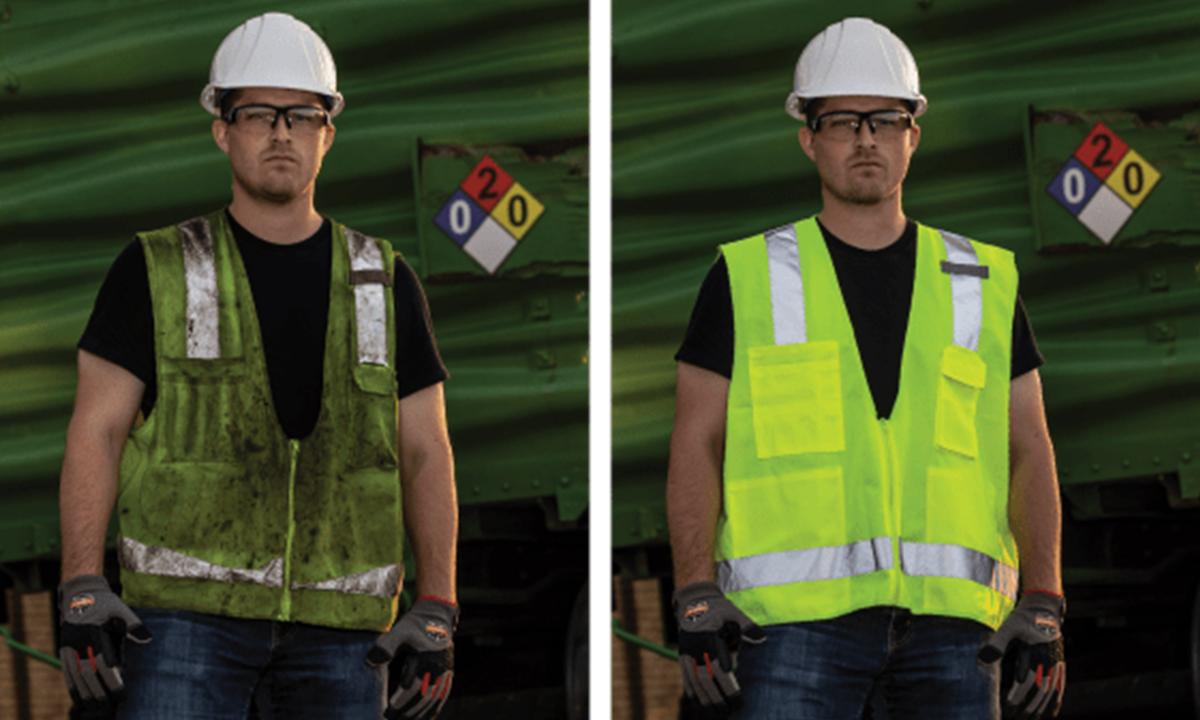
Think you’re too cool to wear a bright new high-vis vest on the job? Afraid you’ll look like the wide-eyed coffee-fetching rookie? Time for a reality check, you ol’ grizzled vet you. If you’re not seen, you’re at risk. And hi-vis gear that’s old, worn and dirty isn’t exactly high visibility anymore. Sure, your tattered and dirt-caked vest may show off all the hours you’ve put in and the hard work accomplished, but it’s not doing its job... which is making sure you’re visible to those around you.
WHAT IS HI-VIS?
High-visibility apparel (or hi-vis) is clothing like jackets, pants, vests, coveralls, etc. that workers can wear to improve how well others see them in a work environment. Hi-vis is especially critical for workers who work around moving vehicles or equipment, especially in low-light environments. By definition, hi-vis has color properties that are easily discernible from any background, and is highly reflective. Fluorescent yellow-green, orange and red (less common in the U.S.) are all approved hi-vis colors because the human eye is most sensitive—and thus responds most quickly—when it sees them. Unlike other colors on the visible spectrum, they are also not subject to the “graying” effect that impacts other colors in low light environments.

The reflective properties come from retroreflective strips on the garment that reflect light back at its original source (like headlights). To be certified, the garment must meet ANSI standards on the widths and amounts of compliant retroreflective material to help enhance a person’s visibility in low-lighting. All compliant hi-vis apparel is required to be balanced in design, which means no less than 40% of the minimum required amount of reflective and background material has to be present on both the front and back of the garment when laid flat. This ensures the worker is visible from both front and back.
DO YOUR WORKERS NEED HI-VIS CLOTHING?
Many workers are either required to wear high-visibility clothing on the jobsite, or choose to wear it to reduce the risk of on-the-job incidents. When it comes to who is required to wear hi-vis, the federal Manual on Uniform Traffic Control Devices 2009 (MUTCD 2009) is translated and enforced on a state-by-state basis. However, OSHA interpreted this mandate to say that employees working on highway maintenance jobs and road construction work zones must wear high-visibility garments when they’re working as flaggers, or are exposed to both public vehicle traffic and/or construction equipment. This mandate includes all workers, including construction, maintenance, utility, emergency/incident responders, and volunteers operating on or near any public-access roadways to wear high-visibility clothing.
Other industries like general construction, airport workers, warehouse workers, linesmen, highway maintenance jobs and a number of other industries may choose to require their employees to wear high-visibility workwear to ensure safety on the job, but as long as the work is not being performed on a public roadway, high visibility clothing is not federally required. However, in all of these industries, there is moving equipment and the risk of injury so high-visibility gear is most definitely a smart idea to prevent accidents.
THE ANSI/ISEA STANDARD
The standards for hi-vis set by the American National Standards Institute and the International Safety Equipment Association (ANSI and ISEA) refers more to the construction of the garment, rather than who needs to wear it.
ANSI/ISEA 107 is the industry regulation established by the American National Standards Institute (ANSI) and the International Safety Equipment Association (ISEA) that sets out garment design requirements for multiple Garment Types for high-visibility vests, jackets, pants and more—plus, five different Performance Classes within those Types. The standard combines two previously recognized hi-vis apparel standards designed to cover garments requirements for non-public safety workers and public safety employees, such as police and firefighters. It also provides performance testing criteria for the materials used to make the garments.
CLASSES & TYPES
The standard sets requirements for the design and minimum amount of fluorescent material and retroreflective material. The standard breaks out three types of garments with 5 performance classes. Each class within the type is indicative of how much of the garment has to be high visibility material. Therefore a Class 3 garment would be more visible, with more retroreflective material and more fluorescent background than a Class 2.
Class 1 garments offer the minimum amount of high-visibility materials needed to differentiate the wearer from non-complex work environments, like warehouses or workers getting shopping carts from a parking lot. Can be in the form of reflective safety vests or high-visibility shirts with less hi-vis material.
On the other end of the high-vis spectrum, Class 3 offers the greatest amount of high-visibility materials to allow for the best definition of the human form in both complex backgrounds and through a full range of movement. This is why Class 3 garments have sleeves with retroreflective tape—to distinguish the worker from objects on the jobsite and add visibility through a full range of motion. Commonly worn by road workers in highway zones or around vehicles/traffic.
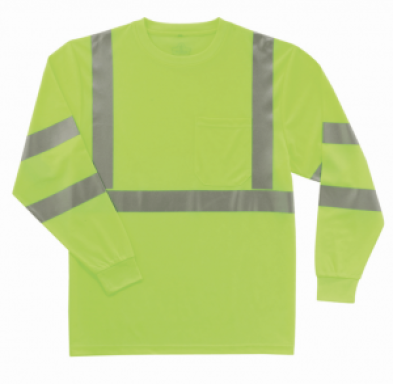
Class 2 falls somewhere in the middle, with more hi-vis materials than Class 1, but less than Class 3. Class 2 garments can be sleeved, either long-sleeved or short-sleeved, but these will not have the reflective tape on the arms.
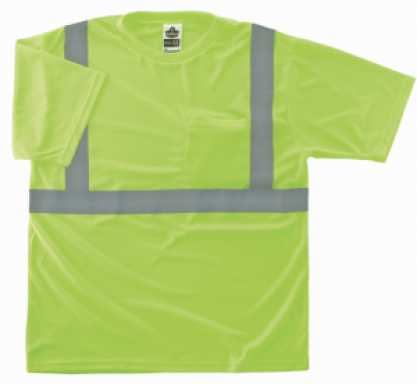
This standard further breaks out the three types of garments into three different Types, which we explain more in-depth in our blog post on Understanding Hi-Vis Standards. Those 3 classes are:
- Type O Hi-Vis (Off-Road): workers not required to wear hi-vis apparel, but are in an environment with moving equipment/vehicles where visibility is a concern
- Type R Hi-Vis (Roadway): workers who are exposed to roadway traffic and are in an area exposed to moving equipment/vehicles
- Type P Hi-Vis (Public Safety): first responders, police, fire and EMS
The chart below illustrates the square inch requirement of background and reflective material. While you may not need to know the exact specs, it shows how much extra visibility your crew will get in Class 3 versus Class 2 gear. Always better to be safe than sorry when it comes to staying visible on the jobsite.
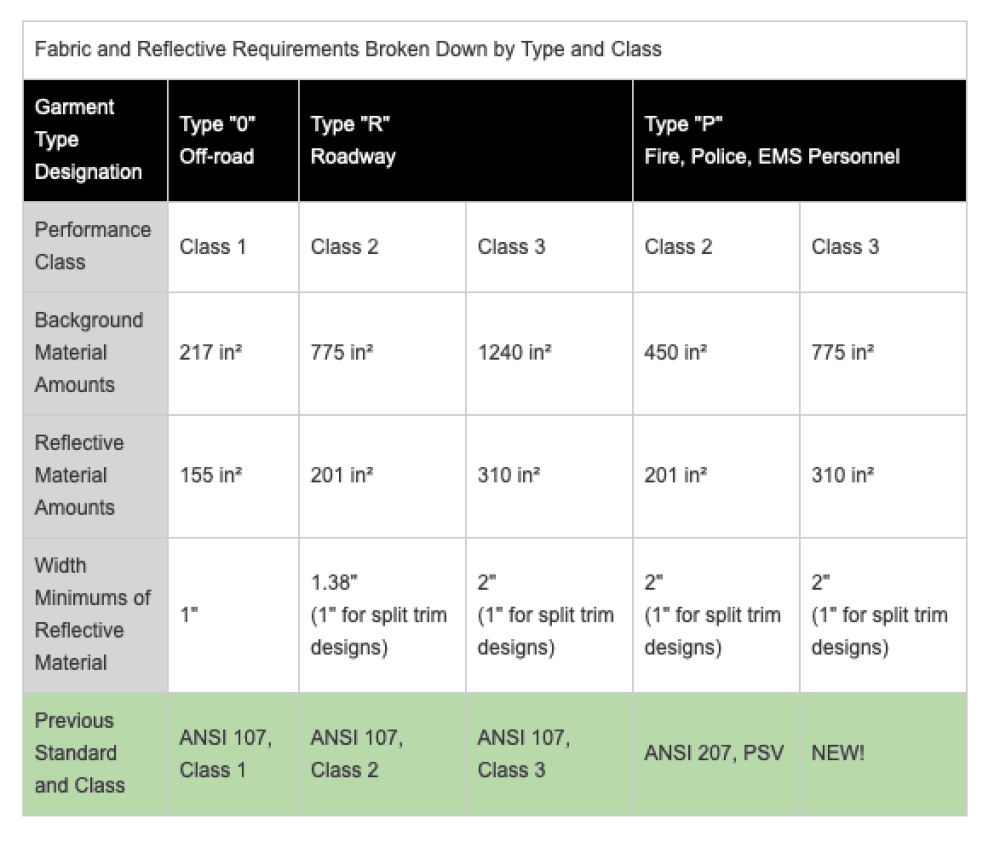
Another thing to note is that you can obtain Class 3 compliance in one of two ways with the first being obvious: wear a Class 3 compliant garment (a fluorescent shirt or a jacket with reflective tape on the sleeves). But you can also take a Class 2 garment like a vest and pair it with Class E compliant bottoms for full Class 3 compliance. Class E is a supplemental class of garments, like pants, leg gaiters, class E vests.
Class 2 + Class E = Class 3!
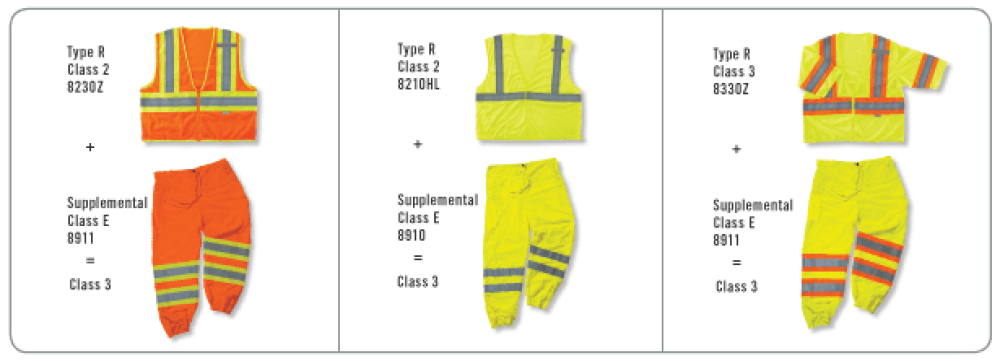
These days, hi-vis gear comes in all shapes and sizes so there’s really no reason NOT to be wearing hi-vis gear on the job. As long as you’re in compliance with the Type and Class your jobsite specifies, you can find hi-vis in a number of different styles to suit your personal preference and fit the climate... like sweatshirts, jackets, tees and vests.
YELLOW VS. ORANGE: WHAT IS THE BEST HI-VIS COLOR?
Above critical distinctions between classes and types, safety managers and workers should also identify the best high visibility color for their jobsite. While fluorescent yellow-green registers the highest level of eye sensitivity, that doesn’t necessarily mean it’s the safest option for all work environments. Consider a worksite surrounded by foliage—in this setting, bright orange would provide a higher contrast than yellow-green amidst the background of green trees. Orange is also a widely accepted hazard signal for drivers, so it may be a better indicator on certain road construction sites.
WHEN TO REPLACE HI-VIS CLOTHING
Even though you might think the more battered and beaten your vest looks, the better, but your gear does have a service life. You’re doing yourself and your crew around you a disservice by letting your hi-vis apparel get damaged and dirt-caked. Dirt and wear and tear on a jobsite is inevitable, but recognizing your gear’s service life is a critical step in staying safe. All high-visibility items have a limited lifetime that will vary widely depending on use. This service life is affected by how you care for the garment, and whether it is being worn in the sun, or exposed to a lot of dirt and debris, or heat. Garments should no longer be worn if they’re torn/cracked, heavily soiled, noticeably faded, burned or otherwise damaged. When it’s time to retire your hi-vis, make sure to cut it in half so it can no longer be worn by anyone.
WHY REPLACE HI-VIS CLOTHING
They say a picture is worth a thousand words and we couldn’t agree more. These pictures drive home the importance of hi-vis on a jobsite. All taken in low-light conditions, it’s easy to see why hi-vis clothing is so important.
No hi-vis. It’s very hard to see the worker and distinguish him from the surroundings. It would be very easy to miss this worker on a busy jobsite. Pretty much asking for trouble with this one.
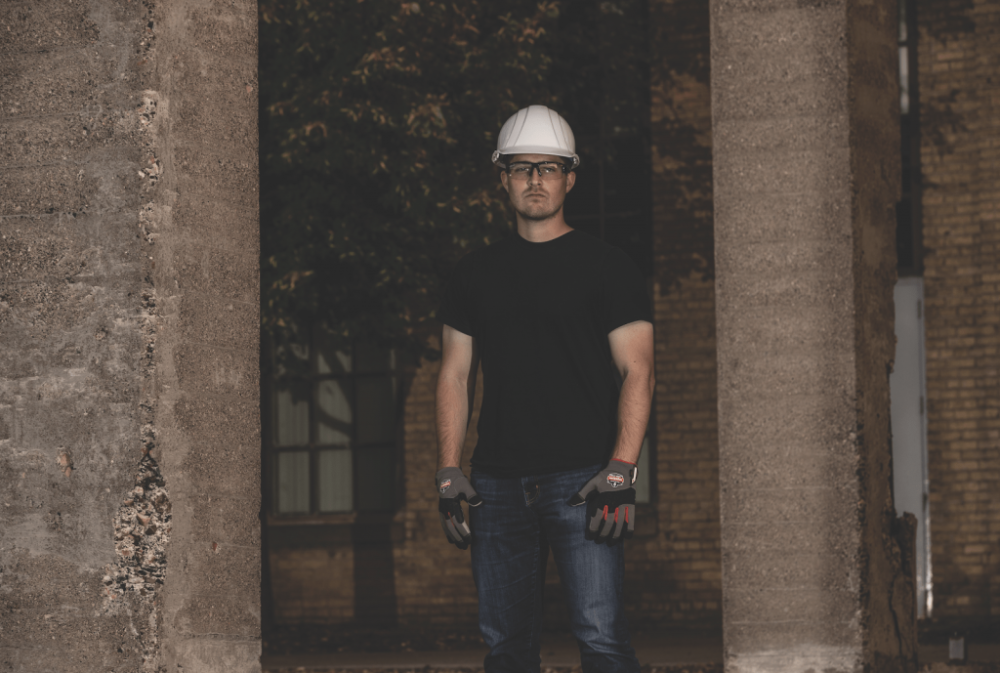
Old hi-vis. It’s better than nothing... but nothing is a pretty low bar. This may look like a badge of honor to some, showing their lengthy service, but to us, this looks like a near-miss (or worse) about to happen.
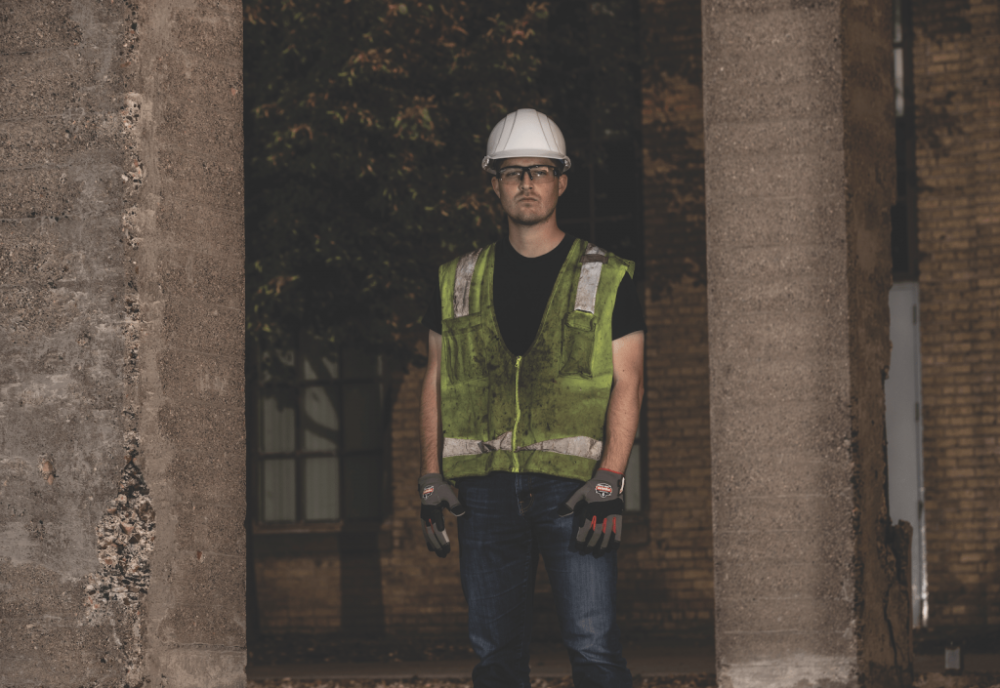
New hi-vis. Bright, vibrant, reflective... keeping you and your crew seen and safe.
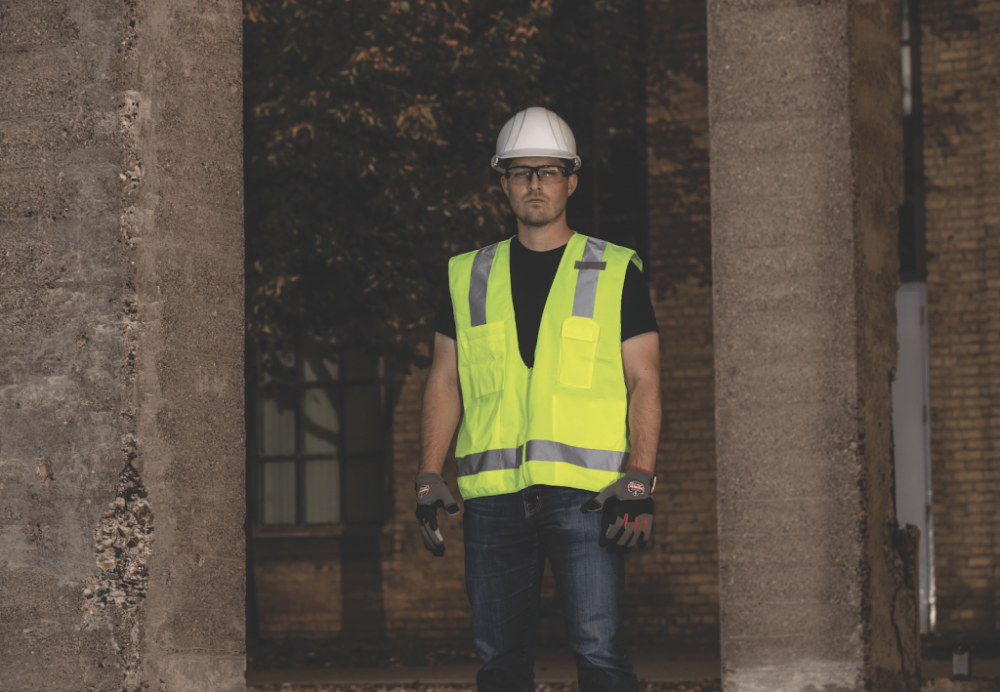
IF YOU’RE NOT SEEN, YOU’RE NOT SAFE
We get it, a well-worn vest conveys that you’re a pro. That you’re not the eager rookie on the jobsite, that you’ve been here awhile and you know your sh...stuff. It’s a pride thing and we GET it. But your point of pride is missing the point. Because if you’re not seen, you’re not safe. So ditch the dirty hi-vis and look like the (smart) seasoned vet that you are.

